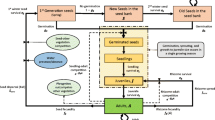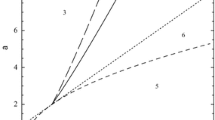Abstract
An analytical model consisting of adult plants and two types of seeds (unripe and mature) is considered and successfully tested using experimental data available for some invasive weeds (Echium plantagineum, Cytisus scoparius, Carduus nutans andCarduus acanthoides) from their native and exotic ranges. The model accounts for probability distribution functions (pdfs) for times of germination, growth, death and dispersal on two dimensions, so the general life-cycle of individuals is considered with high level of description. Our work provides for the first time, for a model containing all that life-cycle information, explicit relationship conditions for the invasive success and expressions for the speed of invasive fronts, which can be useful tools for invasions assessment. The expressions derived allow us to prove that the different phenotypes showed by the weeds in their native (exotic) ranges can explain their corresponding non-invasive (invasive) behavior.
Similar content being viewed by others
References
Allen, E.J., Allen, L.J.S., Xiaoning, G., 1996. Dispersal and competition models for plants. J. Math. Biol. 34, 455–481.
Andersen, M., 1991. Properties of some density-dependent integro-difference equation population models. Math. Biosci. 104, 135–157.
Andow, D.A., Kareiva, P., Levin, S.A., Okubo, A., 1990. Spread of invading organisms. Landsc. Ecol. 4, 177–188.
Bullock, J.M., Kenward, R.E., Hails, R.S., 2002. Dispersal Ecology. Blackwell Science, Oxford.
Campos, D., Fort, J., Llebot, J.E., 2002. Reaction-diffusion wave fronts: Multigeneration biological species under climate change. Phys. Rev. E 66, 062901.
Caswell, H., 1989. Matrix Population Models: Construction, Analysis, and Interpretation. Sinauer Associates, Sunderland.
Caswell, H., Lensink, R., Neubert, M.G., 2003. Demography and dispersal: comparing invasion speeds using life table response experiments. Ecology 84, 1968–1978.
Clark, J.S., 1998. Why trees migrate so fast: confronting theory with dispersal biology and the paleo record. Am. Nat. 152, 204–224.
Clark, J.S., Lewis, M.A., Horvath, L., 2001. Invasion by extremes: population spread with variation in dispersal and reproduction. Am. Nat. 157, 537–554.
Clark, J.S., Lewis, M.A., Mclachlam, J.S., Hille Ris Lambers, J., 2003. Estimating population spread: what can we forecast and how well? Ecology 84, 1979–1988.
Fedotov, S., Méndez, V., 2002. Continuous-time random walks and traveling fronts. Phys. Rev. E 66, 030102(R).
Freidlin, M., 1996. Markov Processes and Differential Equations: Asymptotic Problems. Birkhäuser, Basel.
Grigulis, K., Sheppard, A.W., Ash, J.E., Groves, R.H., 2001. The comparative demography of the pasture weed. Echium plantagineum between its native and invaded ranges. J. Appl. Ecol. 38, 281–290.
Hastings, A., , 2005. The spatial spread of invasions: new developments in theory and evidence. Ecol. Lett. 8, 91–101.
Hoskins, J.R., Smith, J.M.B., Sheppard, A.W., 1998. Cytisus scoparius (L.) Link subsp. scopatrius. In: Panetta, F.D., Groves, R.H., Shepherd, R.C.H. (Eds.), The Biology of Australian Weeds, vol. 2. R.G. & F.J. Richardson Publishers, Melbourne
Jongejans, E., Skarpaas, O., Tipping, P.W., Shea, K., 2007. Establishment and spread of founding populations of an invasive thistle: the role of competition and seed limitation. Biol. Invations 9, 317–325.
Katul, G.G., Porporato, A., Nathan, R., Siqueira, M., Soons, M.B., Poggi, D., Horn, H.S., Levin, S.A., 2005. Mechanistic analytical models for long-distance seed dispersal by wind. Am. Nat. 166, 368–381.
Kot, M., Lewis, M.A., van den Driessche, P., 1996. Dispersal data and the spread of invading organisms. Ecology 77, 2027–2042.
Lewis, M.A., Neubert, M.G., Caswell, H., Clark, J., Shea, K., 2006. A guide to calculating discrete-time invasion rates from data. In: Cadotte, M.W., McMahon, S.M., Fukami, T. (Eds.), Conceptual Ecology and Invasion Biology: Reciprocal Approaches to Nature, pp. 169–192. Springer, Dordrecht
Lotka, A.J., 1956. Elements of Mathematical Biology. Dover, New York.
Méndez, V., Campos, D., Fedotov, S., 2004. Analysis of fronts in reaction-dispersal processes. Phys. Rev. E 70, 066129.
Metzler, R., Klafter, J., 2000. The random walk’s guide to anomalous diffusion: a fractional dynamics approach. Phys. Rep. 339, 1–77.
Mistro, D.C., Rodrigues, L.A.D., Schmid, A.B., 2005. A mathematical model for dispersal of an annual plant population with a seed bank. Ecol. Mod. 188, 52–61.
Montroll, E.W., Weiss, G.H., 1965. Random walks on lattices, II. J. Math. Phys. 6, 167–181.
Murray, J.D., 1993. Mathematical Biology. Springer, Berlin.
Nathan, R., Katul, G.G., Horn, H.S., Thomas, S.M., Oren, R., Avissar, R., Pacala, S.W., Levin, S.A., 2002. Mechanisms of long-distance dispersal of seeds by wind. Nature 418, 409–413.
Neubert, M.G., Caswell, H., 2000. Demography and dispersal: calculation and sensitivity analysis of invasion speed for structured populations. Ecology 81, 1613–1628.
Paynter, Q., Fowler, S.V., Memmott, J., Sheppard, A.W., 1998. Factors affecting the establishment of Cytisus scoparius in southern France: implications for managing both native and exotic populations. J. Appl. Ecol. 35, 582–595.
Sheppard, A.W., Cullen, J.M., Aeschlimann, J.P., Vitou, J., 1988. The importance of insect herbivores relative to other limiting factors on weed population dynamics: a case study of Carduus nutans. In: Proceedings of the VII International Symposium on Biological Control of Weeds, 6–11 March 1988, Rome, Italy. E.S. Delfosse.
Sheppard, A.W., Cullen, J.M., Aeschlimann, J.P., 1994. Predispersal seed predation on Carduus nutans (Asteraceae) in southern Europe. Acta Oecol. 15, 529–541.
Sheppard, A.W., Hodge, P., Paynter, Q., Rees, M., 2002. Factors affecting invasion and persistence of broom Cytisus scoparius in Australia. J. Appl. Ecol. 39, 721–734.
Shigesada, N., Kawasaki, K., Takeda, Y., 1995. Modeling stratified diffusion in biological invasions. Am. Nat. 146, 229–251.
Skarpaas, O., Shea, K., 2007. Dispersal patterns, dispersal mechanisms, and invasion wave speeds for invasive thistles. Am. Nat. 170, 421–430.
Skellam, J.G., 1951. Random dispersal in theoretical populations. Biometrika 38, 196–218.
Turchin, P., 1998. Quantitative Analysis of Movement: Measuring and Modeling Population Redistribution in Animals and Plants. Sinauer, Sunderland.
van den Bosch, F., Metz, J.A.J., Dieckmann, O., 1990. The velocity of spatial population expansion. J. Math. Biol. 28, 529–565.
Woodburn, T.L., Sheppard, A.W., 1996. Life histories of Carduus nutans as a native versus an alien weed. Plant Prot. Q. 11, 236–238.
Author information
Authors and Affiliations
Corresponding author
Rights and permissions
About this article
Cite this article
Méndez, V., Campos, D. & Sheppard, A.W. A Model for Plant Invasions: the Role of Distributed Generation Times. Bull. Math. Biol. 71, 1727–1744 (2009). https://doi.org/10.1007/s11538-009-9422-x
Received:
Accepted:
Published:
Issue Date:
DOI: https://doi.org/10.1007/s11538-009-9422-x




